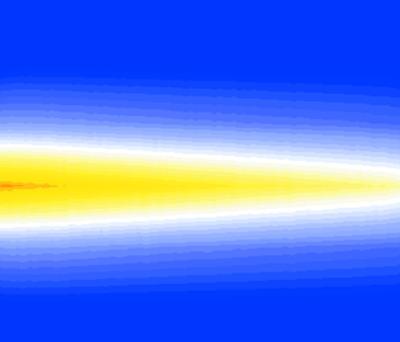当前位置:
X-MOL 学术
›
J. Synchrotron Radiat.
›
论文详情
Our official English website, www.x-mol.net, welcomes your
feedback! (Note: you will need to create a separate account there.)
Time and space resolved modelling of the heating induced by synchrotron X‐ray nanobeams
Journal of Synchrotron Radiation ( IF 2.4 ) Pub Date : 2020-09-16 , DOI: 10.1107/s1600577520010553 Valentina Bonino , Daniele Torsello , Carmelo Prestipino , Lorenzo Mino , Marco Truccato
Journal of Synchrotron Radiation ( IF 2.4 ) Pub Date : 2020-09-16 , DOI: 10.1107/s1600577520010553 Valentina Bonino , Daniele Torsello , Carmelo Prestipino , Lorenzo Mino , Marco Truccato

|
X‐ray synchrotron sources, possessing high power density, nanometric spot size and short pulse duration, are extending their application frontiers up to the exploration of direct matter modification. In this field, the use of atomistic and continuum models is now becoming fundamental in the simulation of the photoinduced excitation states and eventually in the phase transition triggered by intense X‐rays. In this work, the X‐ray heating phenomenon is studied by coupling the Monte Carlo method (MC) with the Fourier heat equation, to first calculate the distribution of the energy absorbed by the systems and finally to predict the heating distribution and evolution. The results of the proposed model are also compared with those obtained removing the explicit definition of the energy distribution, as calculated by the MC. A good approximation of experimental thermal measurements produced irradiating a millimetric glass bead is found for both of the proposed models. A further step towards more complex systems is carried out, including in the models the different time patterns of the source, as determined by the filling modes of the synchrotron storage ring. The two models are applied in three prediction cases, in which the heating produced in Bi2Sr2CaCu2O8+δ microcrystals by means of nanopatterning experiments with intense hard X‐ray nanobeams is calculated. It is demonstrated that the temperature evolution is strictly connected to the filling mode of the storage ring. By coupling the MC with the heat equation, X‐ray pulses that are 48 ps long, possessing an instantaneous photon flux of ∼44 × 1013 photons s−1, were found to be able to induce a maximum temperature increase of 42 K, after a time of 350 ps. Inversely, by ignoring the energy redistribution calculated with the MC, peaks temperatures up to hundreds of degrees higher were found. These results highlight the importance of the energy redistribution operated by primary and secondary electrons in the theoretical simulation of the X‐ray heating effects.
中文翻译:

同步加速器X射线纳米束引起的加热的时空解析模型
具有高功率密度,纳米点尺寸和短脉冲持续时间的X射线同步加速器源将其应用领域扩展到探索直接物质修饰的领域。在这个领域,原子模型和连续模型在模拟光致激发态以及最终由强X射线触发的相变过程中已成为基础。在这项工作中,通过将蒙特卡罗方法(MC)与傅立叶热方程耦合,研究X射线加热现象,首先计算系统吸收的能量的分布,最后预测热量的分布和演变。拟议模型的结果也与去除的明确定义的能量分布所获得的结果进行了比较(由MC计算)。对于两个提议的模型,都发现了用毫米玻璃珠辐照产生的实验热测量值的近似值。朝着更复杂的系统迈进了又一步,其中包括在模型中由同步加速器存储环的填充模式确定的源的不同时间模式。这两个模型用于三种预测情况,其中Bi产生的热量通过使用强硬X射线纳米束的纳米图案实验,计算了2 Sr 2 CaCu 2 O 8 +δ微晶。结果表明,温度的变化与存储环的填充方式密切相关。通过将MC与热方程耦合,X射线脉冲的长度为48 ps,具有〜44×10 13个 光子s -1的瞬时光子通量在350 ps的时间后,发现,能够引起42 K的最大温度升高。相反,通过忽略使用MC计算的能量重新分布,发现峰值温度高出数百度。这些结果强调了在X射线加热效应的理论模拟中,一次电子和二次电子操作的能量重新分配的重要性。
更新日期:2020-11-06
中文翻译:

同步加速器X射线纳米束引起的加热的时空解析模型
具有高功率密度,纳米点尺寸和短脉冲持续时间的X射线同步加速器源将其应用领域扩展到探索直接物质修饰的领域。在这个领域,原子模型和连续模型在模拟光致激发态以及最终由强X射线触发的相变过程中已成为基础。在这项工作中,通过将蒙特卡罗方法(MC)与傅立叶热方程耦合,研究X射线加热现象,首先计算系统吸收的能量的分布,最后预测热量的分布和演变。拟议模型的结果也与去除的明确定义的能量分布所获得的结果进行了比较(由MC计算)。对于两个提议的模型,都发现了用毫米玻璃珠辐照产生的实验热测量值的近似值。朝着更复杂的系统迈进了又一步,其中包括在模型中由同步加速器存储环的填充模式确定的源的不同时间模式。这两个模型用于三种预测情况,其中Bi产生的热量通过使用强硬X射线纳米束的纳米图案实验,计算了2 Sr 2 CaCu 2 O 8 +δ微晶。结果表明,温度的变化与存储环的填充方式密切相关。通过将MC与热方程耦合,X射线脉冲的长度为48 ps,具有〜44×10 13个 光子s -1的瞬时光子通量在350 ps的时间后,发现,能够引起42 K的最大温度升高。相反,通过忽略使用MC计算的能量重新分布,发现峰值温度高出数百度。这些结果强调了在X射线加热效应的理论模拟中,一次电子和二次电子操作的能量重新分配的重要性。











































 京公网安备 11010802027423号
京公网安备 11010802027423号